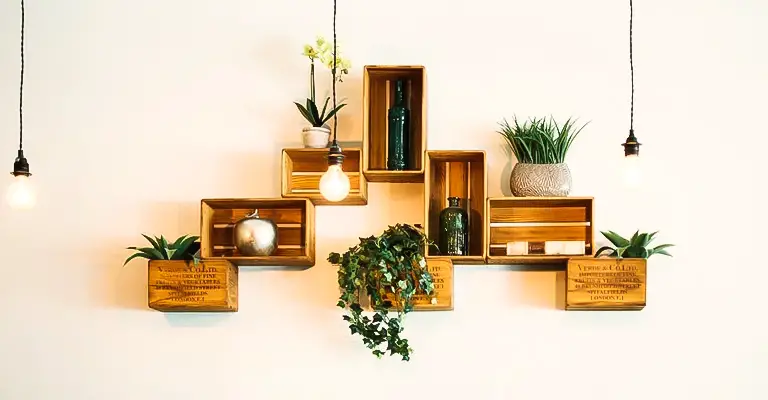Are you looking to spruce up your living space with some stylish shelves, but the thought of hammering nails into your walls makes you cringe?
Or perhaps you’re renting a space and want to avoid damaging the walls with holes that must be patched up later. Well, you’re in luck!
Hanging shelves without nails is not only possible, but it’s also a practical and creative way to add storage and decor to your home.
Can You Hang Shelves Without Putting Holes In The Wall?
In fact, yes. To accomplish this, you’ll need to purchase adhesive mounting strips. Your shelf will need strong adhesive mounting strips designed for pictures or other large items to hang.
When buying strips, ensure they have a weight capacity that can support your shelf and any objects you intend to place on it before making your purchase.
How To Hang Shelves Without Putting Holes In The Wall?
In our previous article, we discussed the fact that the majority of homeowners dislike having holes drilled through the walls. The question now arises as to how to hang wall shelves without drilling.
Look at some creative ideas that can help you decorate to your heart’s content without risking your money.
1. Using Adhesive Mounting Strips
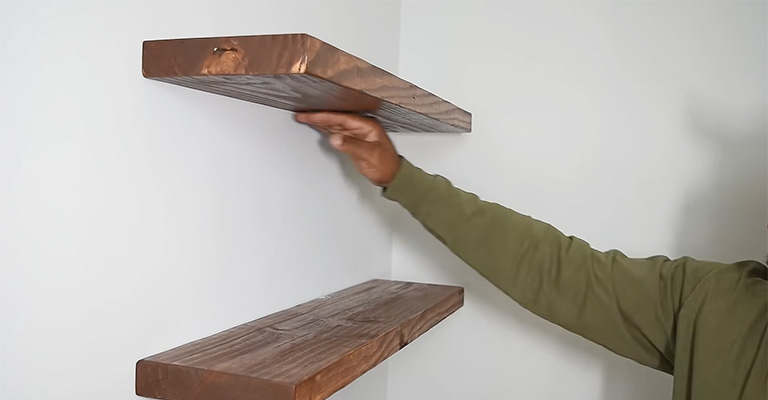
A sturdy adhesive mounting strip is required for hanging your shelf. Installing shelving units on tiles without making holes using these strips is easy.
A variety of sizes can also be customized with these strips. In this way, they are perfect for covering any exterior tile.
A condition, however, applies. You should check their weight capacity before purchasing a set of strips.
As a result, you will ensure that your shelf is adequately supported. This is thus a fascinating method for hanging shelves without nails.
Step 1:
Choose a shelf with a light, hollow structure. When it comes to hanging up extremely heavy shelves made from dense, solid materials like steel or oak, fasteners such as nails are necessary.
You can use adhesive fasteners to hang up light, hollow shelves made from balsa wood or similar materials. Generally, try to hang shelves that weigh 3 lb (1.4 kg) or less.
It is unsafe to hang shelves with adhesive strips weighing more than 10 pounds (4.5 kilograms).
Look for light wood planks in furniture shops, watch out for floating shelves with hollows or at hardware stores.
Step 2:
Mounting strips with adhesive are available for purchase. If you plan on hanging your shelf, you’ll need strong adhesive mounting strips designed for large objects.
It is essential to check the weight capacity of the strips before buying a set to ensure that they can support your shelf and your objects as well.
You can purchase adhesive strips with a sticky, Velcro-like surface on one side and a rough, gripping surface on the other. The material used here is not identical to what is used in Command hooks.
Many adhesive strips, such as Command picture hanging strips, Scotch retractable fasteners, and Velcro removable mounting strips, are popular. The products can be purchased at most craft and office supply stores.
It is also possible to use moldable adhesive glue for extremely tiny or light shelves.
Step 3:
You can clean your shelf and wall with isopropyl alcohol. With isopropyl alcohol, moisten a fresh cleaning cloth.
Then, rub the cloth gently against your wall and the shelf’s mounting side. You should give your surfaces around 5 minutes to dry before attaching adhesive strips.
When you do this, you will help remove grease, oil, and wax from the surfaces so the adhesive strips will be easier to mount. Various big-box and drug stores sell isopropyl alcohol.
Step 4:
Ensure your strips are pressed down on the shelf for 30 seconds before removing them. Attach the mounting strips to each other using Velcro-style fastenings if they are not already attached.
When finished, remove one of the strips’ protective liners, press the adhesive side down on your shelf’s mounting area, and hold it for about 30 seconds.
Make sure you repeat this step for the remaining strips. Make sure you space your strips evenly to provide maximum hanging strength. For shelf attachments made of wood, use staples.
Step 5:
Keep your shelf attached to the wall for 30 seconds. Place the shelf along the wall after attaching the adhesive strips.
Remove the remaining strip liners before positioning the shelf. Put your shelf against the wall for 30 seconds, then secure it with a clamp.
It’s best to attach adhesive strips to the two adjacent sides of the shelf and hang them in a corner. You will have a better chance of supporting your shelf this way.
Step 6:
You must remove your shelf and press down each strip for 30 seconds. Peel the shelf away from the wall by pulling on its edges with slow, careful movements.
Ensure that the strip pairs are separated so that one side is attached to the wall and the other side is attached to the shelf.
To ensure complete adhesion, you should then push down for 30 seconds on each adhesive strip individually.
Secure a new strip on your shelf and repeat the attachment and removal process whenever your shelf strip comes off.
Step 7:
You should replace the shelf after one hour. You should let your adhesive strips set for about an hour before using them.
You must connect the adhesive strips behind the shelf before reattaching it. Keep a close eye on your shelf as you let go and ensure it won’t fall.
You can use blankets or pillows below your shelf to catch the shelf if it falls.
Step 8:
On your shelf, place light and durable objects. The shelf cannot hold heavy objects, such as textbooks and appliances, without fasteners, such as nails.
In general, however, it should be able to accommodate small trinkets, lightweight electronics, and similar items.
2. Velcro Strips
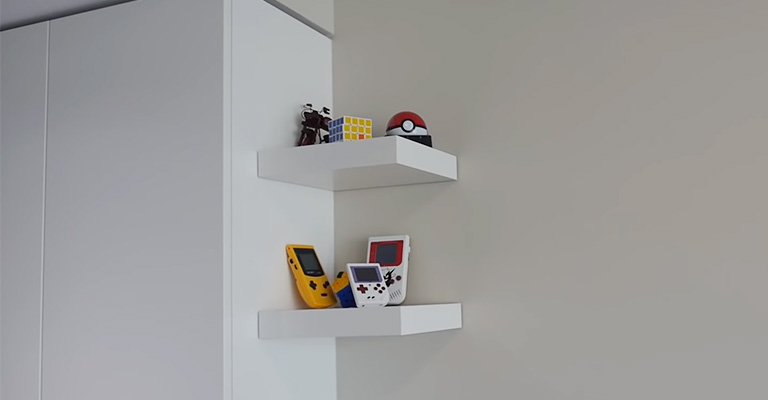
Wall mounts for shelves made from Velcro strips are perhaps the least reliable. It is only recommended to use Velcro strips to hang small light shelves. Based on Velcro company information, Velcro strips can hold up to 5 pounds per square inch.
If you want to hang shelves, Velcro strips will work best since they are small enough to hold one or two items. It may be necessary to use multiple Velcro strips on the shelf if they are thick.
It is also possible to hang objects individually on the wall using Velcro strips instead of hanging the shelf.
Place some small candles on a wall and stick the Velcro strips on it. For example, if you want to place some small candles on a shelf, ditch the shelf. The decorative effect of hanging candles on the wall can be very effective.
3. Construction Glue
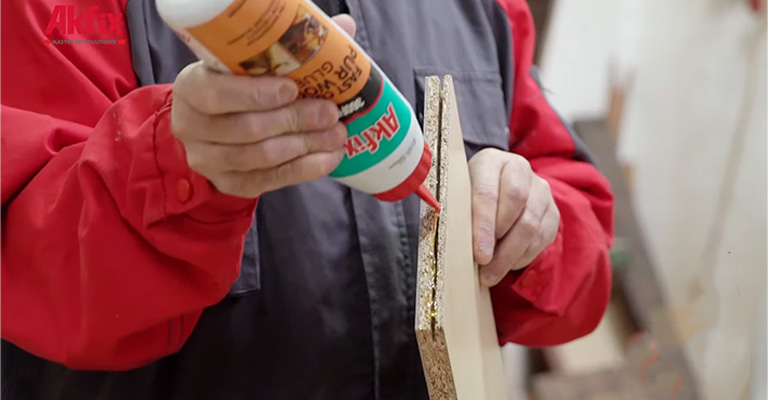
Construction glue is different from what you’d find in a hobby shop or even an automobile shop. Construction is strong enough to hold anything in place.
Use general-grade construction glue for shelves inside your house, and for outdoor shelves, use exterior-grade construction glue.
A heavy-duty construction adhesive glue can last for years after it has been applied, dried, and cured. You can hold anywhere from 15 to 30 pounds with construction glue.
You must scrape the glue off the wall when removing the construction glue. Damage to the paint can result from using the scraping tool.
Also, you can remove construction-grade glue from the wall using an adhesive remover. In this way, the paint on the wall is less likely to be damaged.
4. Scotch Fasteners
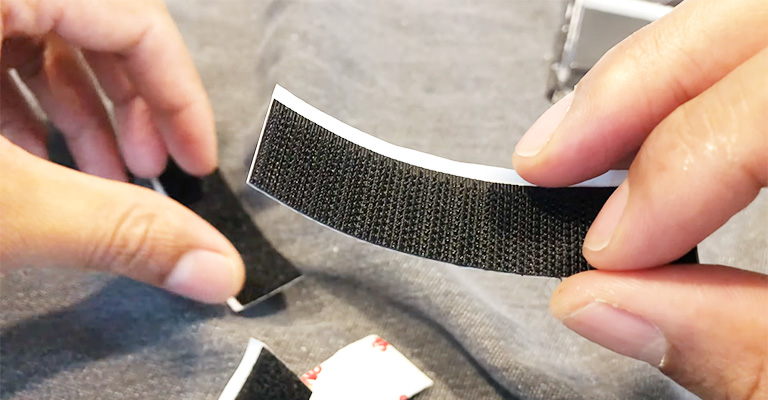
To hang a shelf from a shell, use a Scotch fastener if it is small, and you want to hold minor items such as a candle or a battery-powered humidifier. Scotch fasteners can be removed easily when you need to take off the shelf.
Scratches and scrapes do not need to be done on the wall. You shouldn’t just use one Scotch fastener on the wall and the shelves; use five or six.
5. Suction Cups Shelves
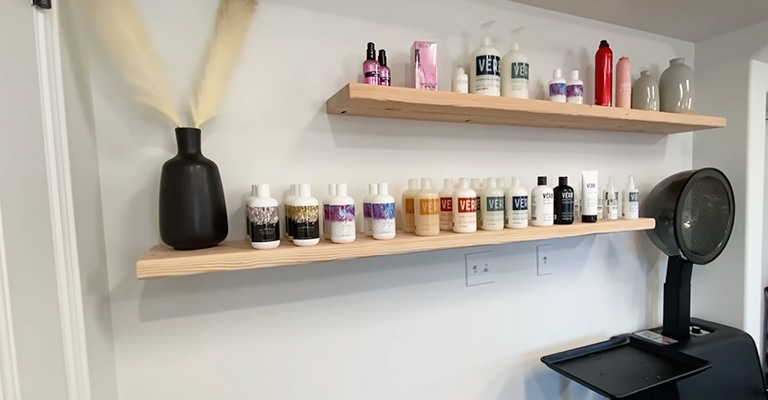
We all need small shelves in our bathrooms, near sinks and toilets, or in bathtubs and showers. However, installing a standard shelf in the bathroom is not a good idea.
In small bathrooms, shelves can build up mold and obstruct access to the door or toilet. However, a suction cup shelf in the shower or bathtub will have the necessary surface area for soaps, shampoos, conditioners, lupus, and bathing oils.
You can find suction cup shelves in bathrooms and toiletry areas in big box stores and grocery stores.
Placing a suction cup shelf in the bathroom is impossible if the surface is moist. Pressing firmly on the suction cup is essential, and the wall must be dry.
Alternative Options
You might have encountered the dreaded “no modifications” rule if you lived in an apartment, dorm, or similar place.
If you’re worried about your security deposit getting taken, don’t worry; there’s an easy way to hang things like shelves.
A Free-Standing Shelf
Free-standing shelves provide more space and stability. It is not uncommon for an adhesive-mounted shelf not to meet your needs, such as a heavy load capacity or adequate storage space.
In such cases, you might consider free-standing shelving systems such as bookshelves and storage racks. Big-box stores and furniture supply stores typically carry free-standing shelves.
Following the assembly instructions enclosed with your purchase will allow you to quickly set up a free-standing shelf.
Place Adhesive Strips
Apply adhesive strips to the back of objects before sticking them to the wall. Rather than hanging a shelf for a photo, painting, or other relatively flat thing, consider directly attaching it to the wall.
You must rub the back of your object with isopropyl alcohol and let it dry for about five minutes before you apply the strips. Afterwards, adhere your strips to the item’s corners and mount it just like a shelf on the wall.
Remove the hanging hardware from a picture frame before you attach adhesive strips. Make sure your painting can withstand the load capacity of an adhesive strip set before buying.
Adhesive Fixtures
You can use adhesive fixtures to hold up light objects. It might be better to purchase a lightweight adhesive fixture rather than putting up a shelf to hold clothes, jewelry, and small electronics.
Many big-box stores have hooks and hangers, which are the most common adhesive fixtures. In addition, you can buy several other unique fixtures online, including:
- The adhesive rails can be used to hold keys and other small items.
- Adhesive caddies can store things like phones, kitchen spices, and bathroom supplies.
- These adhesive display ledges are ideal for showcasing light knick-knacks and other collectables.
Notes
Most big box or independent hardware stores offer the items required for installing new shelves.
It is important to prepare the space before hanging anything on your wall. Remove all the dust from the walls by wiping them gently with a rag.
Use a pencil to sketch where shelves will be installed before installing them onto a wall. Marking the wall with a pencil is always a good choice since the markings can be erased using the eraser.
When you sketch where each shelf will go on the wall, you can visualize how the room will look once it is completed.
Final Words
With adhesive strips or adhesive shelves on the wall, you cannot load them with heavy objects like you can with a nail-hung shelf.
It is recommended that you should not overload each shelf with more than 25 pounds. You can use nails if you want to put something heavier than 25 lbs.
When you use a leveler, you can be sure that the strip, grip, and shelf are placed correctly and evenly.

